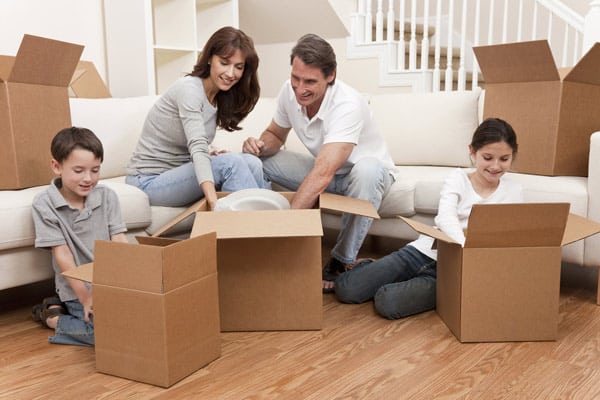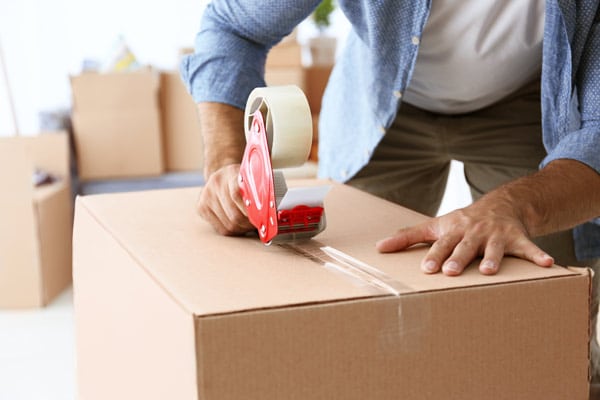Packing boxes for moving is quite a straightforward task – all you need to do is put some items in a box, seal it shut, and label it. Yet, things are not as simple as they seem – if the box is not packed correctly, the risk of accidents and damages increases tenfold:
- The box may collapse under its own weight, causing its contents to fall out – the falling items will almost certainly get broken or damaged and may also cause property damage and/or personal injuries;
- The box may cave in when another box or a heavy item is placed on top of it in the moving truck – as a result, the items in the box may get damaged and the boxes or items on top may topple over and get damaged or cause damage to other items in the truck;
- The items in the box may shift during the move and get damaged; etc
To avoid such unfortunate scenarios and ensure the safety of your belongings, the safety of your property, and the safety of everyone involved in the moving process, you need to know how to pack moving boxes properly and securely.
Read on to find out the best way to pack boxes for moving:
What kind of boxes to use for moving?
Practical and affordable, cardboard boxes are considered the best packing containers for moving. They’re quite sturdy and provide good protection to the items inside them – and they’re also very convenient.
Cardboard boxes come in different sizes and every size is suitable for different kinds of items:
- Small boxes are ideal for small but heavy items such as books and tools, as well as for fragile items that need to be packed separately from other items;
- Medium-sized boxes are very versatile and can be used for clothes and shoes, toys and games, small appliances and electronics, pots and pans, and many other household items;
- Large boxes are best for pillows, linens, curtains, winter clothes, and other bulky lightweight items.
There are specialty moving boxes too – designed to fit and protect specific items:
- Wardrobe boxes – tall boxes equipped with a metal hanger bar for hanging clothes;
- Dish packs – heavy-duty boxes that provide extra cushioning and security to breakables such as chinaware, glassware, and crystal items;
- Picture boxes – telescopic boxes that can fit framed artwork or large mirrors and come with special frame protectors for added safety; etc.
It’s best to buy brand-new packing boxes for your move, but if you want to reduce your packing expenses, you can easily find used boxes for free – just make sure the cartons are clean, dry, and sturdy, without any rips, tears, or damage to the corners.
How to pack boxes for moving?
Moving boxes are really easy to use, but that doesn’t mean that you can simply throw a few items in the carton and close the lids – you need to pack your boxes with care, so your items have a better chance to survive the move safe and intact.
Here is how to pack a moving box the right way:
- Reinforce the bottom and the corners of the box with quality packing tape – to reduce the risk of the carton falling apart or breaking under its own weight during the move.
- Line the bottom of the box with several sheets of packing paper or newspaper, pieces of bubble wrap, or an old towel – to create a cushioning layer that will absorb shocks and vibrations during transit.
- Wrap any fragile items you intend to put in the box with packing paper or bubble wrap – to keep your breakables safely cushioned and prevent them from coming in contact with another item in the box.
- Place heavier items on the bottom and lighter ones on top of them – to ensure that the heavier objects won’t crush the more delicate items in the box.
- Fill the box to the top – to make sure the box won’t cave in when stacked under another box or heavy item in the moving truck (and avoid wasting space when packing for your move, of course). Be careful not to overload the packing container though – the lids should close properly and the sides of the carton should not bulge.
- Do not make the box heavier than 45 lbs – to reduce the risk of accidents (heavy boxes are more likely to give out at the bottom – and more likely to be dropped, as they’re more difficult to carry). Always pack heavy items in small boxes – large moving boxes can fit a lot of items and if you fill them with weighty objects, the big packing containers will become extremely heavy and, therefore, very difficult to lift and carry and quite likely to collapse or get dropped.
- Add plenty of padding in the box – to provide some extra cushioning and prevent the items in the box from shifting during transportation. Fill any empty space in the packing container with crumpled paper, pieces of bubble wrap, packing peanuts, old clothes or towels, etc. and place a protective layer of padding materials on top of the packed items.
- Close the box and shake it gently – to make sure nothing moves inside the carton. If you detect any movement, open the box and add some more cushioning materials inside it.
- Seal the box tightly – to make sure it won’t accidentally open during the move and its contents won’t spill out if the carton is turned sideways or upside down. Use quality packing tape to seal the box – tape down the seam between the top flats, allowing the tape to extend over the sides of the box, then add a couple of tape lines on top of and perpendicular to the center line (or just run a strip of tape diagonally to the strip in the center).
- Label the box properly – to provide handling instructions and make things easier when unloading and unpacking your items. Label the box with its contents and destination room so you (or your movers) can take it directly to the room it belongs to upon arrival at your new home and you know where to find what when you start unpacking. Write any necessary handling instructions, such as FRAGILE, HANDLE WITH CARE, etc., in big letters with a permanent marker on at least three sides of the box (to make sure the instructions are clearly visible even when the boxes are stacked), so the people handling the box know whether they need to be extra careful with this specific carton, what side needs to be up, etc.
Knowing how to pack a box for moving in a safe and efficient way will help you reduce the risk of damage to your items and ensure a successful, stress-free relocation. You will have peace of mind that your items are well protected (so the relocation process will be less stressful) – and you won’t need to deal with repairing or replacing damaged items, neither will you lose items of high sentimental value (so you will save yourself a lot of money, headaches, and heartache).
Keep in mind, though, that movers don’t assume liability for items they have not packed themselves. So, if you’re not sure how to provide your belongings with top-notch protection, have specialty items that require specialized packing materials or packing techniques, or don’t have the time to pack each and every item with utmost care, it may be better to hire professional packers to do the job for you.










